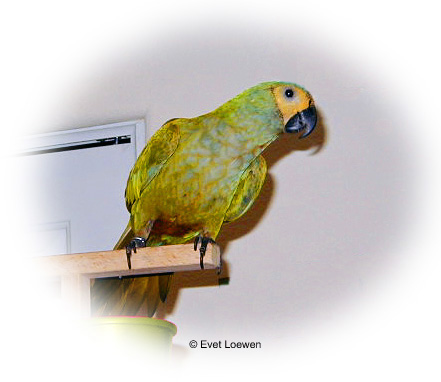The acquisition of my severe macaw, Pepper, had taught me the importance of getting an avian veterinarian to check any new birds to be introduced into the flock at the earliest possible time. So, at least I was educable in that sphere!

By the year 2000, my avian veterinary clinic was For the Birds, now located in San Jose, California. Dr. Fern Van Sant, DVM had taken over as the principal avian veterinarian for the flock from her associate, Dr. Hilary Stern, DVM. Both of them are excellent, knowledgeable, and caring about avians and their human clientele. They are thorough in their exams, and I came to simply accept their standards as the template. For the Birds has been a practice devoted 100% to extraordinary avian care for many years.
Even with my confidence in For the Birds, I decided to seek Sophia's first wellness exam from a third avian veterinarian in the San Francisco Bay Area, also with an excellent background for avian care, and with some experience with Red Bellied Macaws. Not many avian veterinarians had experience with the species, and I thought it important that Sophia be seen by one who did.
It was a week into May before I took Sophia for her wellness exam. It was also her first time being transported in a car with me. She had not settled in to the rest of the flock yet, and I thought it would be a rough ride for her.
Instead she was intensely curious, not making an anxious sound at all and looking all around at the scenery as we drove. Perhaps the drive gave visual stimulation, like flight, I thought.
As far as I could tell, the medical exam went extremely well. Sophia's featheration was pronounced excellent. A second DNA test was run to verify gender, and again came back that macaw was indeed female. A CBC was returned as normal, as was a fecal culture. No lesions or papillomas in the choana or cloaca. I frankly did not know what to look and listen for regarding the health status of this bird and so simply heard the term "nice bird" or "beautiful featheration". The one type of bloodwork not done at this time was for uric acid levels, and I did not understand the significance of that bloodwork until many months later.
With the wellness exam over and the indications positive, I didn't see a need to do anything further with regard to her health. I could begin to oversee her integration into the flock.
Over time, I learned that assuming knowledge that is really outside one's expertise is a dangerous thing; a little knowledge is a dangerous thing; the equivalent of nearly no knowledge is also perilous. It's a very fine line to walk with any avian species, and also with veterinarians.
The easy proclivity of the Red Bellied Macaws to gout and kidney disease was well-known even at the time Sophia came to me. Being knowledgeable enough to request bloodwork on uric acid levels would have been the right way to be. I didn't understand the need for UA bloodwork on this species, and I didn't take Sophia in to For the Birds for a workup. I think I just told the staff at my regular clinic that everything was cool, and assumed it was.
I was in essence a bird-owner-in-training. Over several years, I found the best relationship to have with any avian veterinarian treating my flock is a collaborative one, where either party could ask questions of the other and neither one would become defensive in giving the answer. Honesty was definitely the best policy even if it were slow in coming.
Case in point. At Dr. Van Sant's office, the veterinary technicians on a well bird exam would come out to inspect whatever parrot that was brought in and peer into the carrier to take an initial look-see at the bird and whatever else happened to be in the carrier. A brief report of that look-see would be given to Dr. Van Sant before the owner came into the exam room. A brief comment would then be made during the exam of the dangers of sunflower and safflower seeds, or peanuts, or the soft cotton rope toy given to keep that bird semi-entertained in the carrier and more likely to simply be pooped on.
So, did I stop giving the birds sunflower or safflower seeds, or peanuts, or cotton ropes? Noooo. I did diligently remove these items from the carriers prior to taking birds in to see Dr. Van Sant, however. That way, it became a case of "see no evil" on the part of the vet tech, and "hear no evil" on my part. Wasn't too hot for the bird, though. Dr. Van Sant does have a good sense of humor and really laughed out loud when I finally confessed to this ruse.
As a lawyer, I'm inclined to investigate facts for clients and ask questions. However, all along the way with my birds, I've not asked all the questions that could have been asked. The birds have all had to teach me about their needs. It's a tough job, but some bird has gotta do it.
And they all have. Whether they wanted to, or not.
Next up: Red Bellied Macaw Chronicles Part 6 - Feather Studies
































